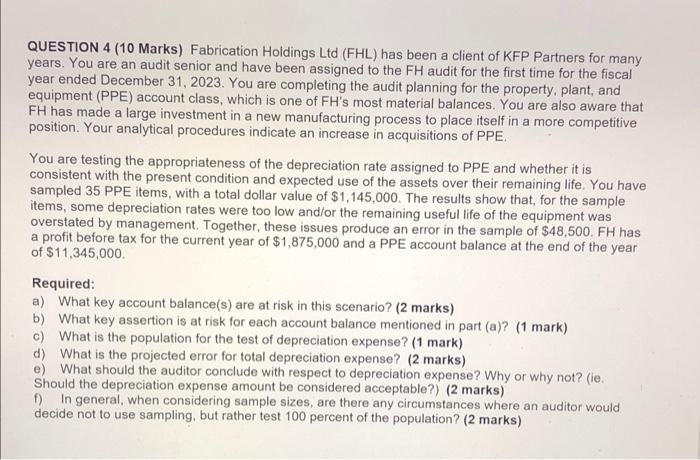QUESTION 4 (10 Marks) Fabrication Holdings Ltd (FHL) has been a client of KFP Partners for many years. You are an audit senior and have been assigned to the FH audit for the first time for the fiscal year ended December 31, 2023. You are completing the audit planning for the property, plant, and equipment (PPE) account class, which is one of FH's most material balances. You are also aware that FH has made a large investment in a new manufacturing process to place itself in a more competitive position. Your analytical procedures indicate an increase in acquisitions of PPE. You are testing the appropriateness of the depreciation rate assigned to PPE and whether it is consistent with the present condition and expected use of the assets over their remaining life. You have sampled 35 PPE items, with a total dollar value of $1,145,000. The results show that, for the sample items, some depreciation rates were too low and/or the remaining useful life of the equipment was overstated by management. Together, these issues produce an error in the sample of $48,500. FH has a profit before tax for the current year of $1,875,000 and a PPE account balance at the end of the year of $11,345,000 Required: a) What key account balance(s) are at risk in this scenario? (2 marks) b) What key assertion is at risk for each account balance mentioned in part (a)? (1 mark) c) What is the population for the test of depreciation expense? (1 mark) d) What is the projected error for total depreciation expense? (2 marks) e) What should the auditor conclude with respect to depreciation expense? Why or why not? (ie. Should the depreciation expense amount be considered acceptable?) (2 marks) f) In general, when considering sample sizes, are there any circumstances where an auditor would decide not to use sampling, but rather test 100 percent of the population? (2 marks) QUESTION 4 (10 Marks) Fabrication Holdings Ltd (FHL) has been a client of KFP Partners for many years. You are an audit senior and have been assigned to the FH audit for the first time for the fiscal year ended December 31, 2023. You are completing the audit planning for the property, plant, and equipment (PPE) account class, which is one of FH's most material balances. You are also aware that FH has made a large investment in a new manufacturing process to place itself in a more competitive position. Your analytical procedures indicate an increase in acquisitions of PPE. You are testing the appropriateness of the depreciation rate assigned to PPE and whether it is consistent with the present condition and expected use of the assets over their remaining life. You have sampled 35 PPE items, with a total dollar value of $1,145,000. The results show that, for the sample items, some depreciation rates were too low and/or the remaining useful life of the equipment was overstated by management. Together, these issues produce an error in the sample of $48,500. FH has a profit before tax for the current year of $1,875,000 and a PPE account balance at the end of the year of $11,345,000 Required: a) What key account balance(s) are at risk in this scenario? (2 marks) b) What key assertion is at risk for each account balance mentioned in part (a)? (1 mark) c) What is the population for the test of depreciation expense? (1 mark) d) What is the projected error for total depreciation expense? (2 marks) e) What should the auditor conclude with respect to depreciation expense? Why or why not? (ie. Should the depreciation expense amount be considered acceptable?) (2 marks) f) In general, when considering sample sizes, are there any circumstances where an auditor would decide not to use sampling, but rather test 100 percent of the population? (2 marks)







